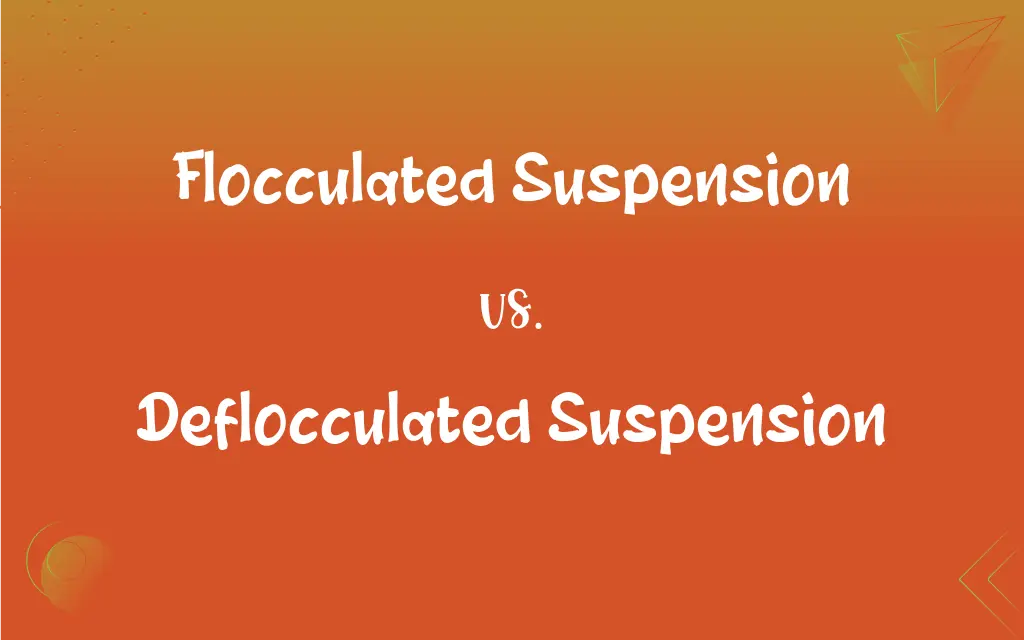Flocculated Suspension vs. Deflocculated Suspension: What's the Difference?
Edited by Aimie Carlson || By Janet White || Published on March 21, 2024
Flocculated suspensions have particles clumped together, settling quickly but easily resuspended, while deflocculated suspensions have dispersed particles, settling slowly and forming a hard cake.

Key Differences
Flocculated suspensions are characterized by the aggregation of particles into loose, fluffy clusters known as flocs. These clusters allow the suspension to settle more rapidly due to the increased effective mass, yet they can be easily redispersed upon shaking. Deflocculated suspensions, on the other hand, are marked by the presence of finely divided particles that remain individually dispersed within the suspension medium. Due to the absence of aggregates, these suspensions tend to settle more slowly than flocculated ones.
The stability of a deflocculated suspension is typically higher over long periods compared to a flocculated suspension, as the particles resist aggregation. This stability is achieved through various means, including the adjustment of the pH, the addition of surfactants, or the use of polymers to increase repulsive forces between particles. In flocculated suspensions, the loose aggregation of particles enhances the suspension's overall appearance and usability immediately after shaking. However, the physical stability over time may be less than that of deflocculated suspensions, as the floccules can compact under certain conditions, leading to changes in the suspension's properties.
Deflocculated suspensions, due to their fine particle dispersion, often require careful formulation to maintain stability and prevent the particles from aggregating over time. The use of stabilizers and the control of environmental conditions are crucial in preserving the deflocculated state. Despite the challenges in handling and storage, deflocculated suspensions are essential in applications where a high degree of particle dispersion and stability against sedimentation are required.
Comparison Chart
Particle Aggregation
Particles form loose clusters.
Particles remain individually dispersed.
Settling Rate
Settles quickly.
Settles slowly.
ADVERTISEMENT
Resuspension
Easily resuspended by shaking.
Hard cake forms, difficult to resuspend.
Stability
Lower physical stability over time.
Higher stability, particles resist aggregation.
Use Case
Preferred where quick sedimentation and easy resuspension are desired.
Used in applications requiring high dispersion and stability.
Flocculated Suspension and Deflocculated Suspension Definitions
Flocculated Suspension
Characterized by quick settling of particles.
The flocculated suspension in the bottle settled quickly, but was easily mixed again.
Deflocculated Suspension
High stability against particle aggregation.
The deflocculated suspension maintained its consistency due to added stabilizers.
ADVERTISEMENT
Flocculated Suspension
Forms a loose sediment layer.
The flocculated suspension left a fluffy layer of sediment at the bottom of the jar.
Deflocculated Suspension
Suspension with individually dispersed particles.
The deflocculated suspension remained uniform without settling for hours.
Flocculated Suspension
Ideal for formulations requiring redispersion.
This medication is a flocculated suspension to ensure uniform dosing with each use.
Deflocculated Suspension
Settles slowly, forming a hard cake.
Once settled, the deflocculated suspension formed a compact layer that was hard to mix.
Flocculated Suspension
Easily resuspended upon agitation.
Shaking the container quickly redispersed the flocculated suspension.
Deflocculated Suspension
Requires careful formulation for stability.
Special surfactants were used to keep the deflocculated suspension stable.
Flocculated Suspension
A suspension where particles cluster into flocs.
The paint mixture formed a flocculated suspension after sitting undisturbed.
Deflocculated Suspension
Challenging to resuspend after settling.
After a week, the deflocculated suspension required vigorous shaking to attempt resuspension.
FAQs
What defines a flocculated suspension?
Particles clump into loose clusters, allowing for easy resuspension.
What is the advantage of flocculated suspensions in pharmaceuticals?
They allow for easy and consistent resuspension before use.
Why do flocculated suspensions settle quickly?
The larger floc size increases the settling rate.
Do deflocculated suspensions show clear separation upon settling?
No, they form a dense, hard cake without a clear supernatant.
How does particle size affect flocculation?
Smaller particles tend to form flocs more readily due to their surface energy.
Can flocculated suspensions form a clear supernatant?
Yes, due to rapid settling, a clearer supernatant forms above the sediment.
What challenge do deflocculated suspensions face in pharmaceuticals?
Ensuring uniform dosage due to the hard cake formation.
Can deflocculation be reversed?
Yes, by altering the formulation or environmental conditions to promote aggregation.
What characterizes a deflocculated suspension?
Particles remain finely dispersed, resisting aggregation.
How can flocculation be induced in suspensions?
By adding electrolytes or adjusting pH to reduce repulsive forces.
Why are deflocculated suspensions hard to resuspend?
The dense particle packing forms a compact sediment.
Can both flocculated and deflocculated suspensions be used in the food industry?
Yes, depending on the desired texture and stability of the product.
What implications does flocculation have on water treatment?
It aids in the removal of suspended particles by promoting rapid sedimentation.
What methods maintain a suspension in a deflocculated state?
Using surfactants or polymers to increase repulsion between particles.
What role do dispersing agents play in deflocculated suspensions?
They prevent particle aggregation, maintaining the suspension's stability.
How does the choice between flocculation and deflocculation impact product formulation?
It determines the suspension's stability, appearance, and usability, affecting the choice of additives and processing conditions.
Which type of suspension is more stable over time?
Deflocculated suspensions, due to their resistance to particle aggregation.
Why might a flocculated suspension be preferred in some applications?
For its ease of redispersion and handling.
How do environmental factors affect flocculated and deflocculated suspensions?
pH, ionic strength, and temperature can influence stability and aggregation.
Is sediment volume higher in flocculated or deflocculated suspensions?
Flocculated suspensions typically have a higher sediment volume.
About Author
Written by
Janet WhiteJanet White has been an esteemed writer and blogger for Difference Wiki. Holding a Master's degree in Science and Medical Journalism from the prestigious Boston University, she has consistently demonstrated her expertise and passion for her field. When she's not immersed in her work, Janet relishes her time exercising, delving into a good book, and cherishing moments with friends and family.
Edited by
Aimie CarlsonAimie Carlson, holding a master's degree in English literature, is a fervent English language enthusiast. She lends her writing talents to Difference Wiki, a prominent website that specializes in comparisons, offering readers insightful analyses that both captivate and inform.































































